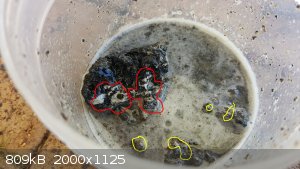toothpick93
Harmless

Posts: 44
Registered: 26-2-2013
Member Is Offline
Mood: No Mood
|
|
Elemental Sodium from slag
I done the reaction between Magnesium and Sodium today and when I broke up the slag that had formed I saw what reminded me of veins of ore in stone.
What is this? I know I have beads of sodium (circled as yellow) just I'm curious to know what it is circled in red.
Also I used vegetable oil instead of mineral as I had none, this is why it might like a but frothy.

|
|
|
krabpustelnik
Harmless

Posts: 9
Registered: 15-8-2015
Member Is Offline
Mood: No Mood
|
|
| Quote: | | I done the reaction between Magnesium and Sodium |
What do you mean ? I think it was reaction between magnesium and sodium hydroxide ? Did you use any catalyst ? Did you use magnesium powder or pieces
?
|
|
|
ave369
Eastern European Lady of Mad Science
   
Posts: 596
Registered: 8-7-2015
Location: No Location
Member Is Offline
Mood: No Mood
|
|
Toss the slag in water. If you see bubbles of hydrogen, then it's sodium. If you don't see any, it's magnesium.
Smells like ammonia....
|
|
|
Tdep
National Hazard
   
Posts: 516
Registered: 31-1-2013
Location: Laser broken since Feb 2020 lol
Member Is Offline
Mood: PhD is done! It isn't good but it's over lol
|
|
A white product from a magnesium reduction? Like... Magnesium oxide and hydroxide?
|
|
|
elementcollector1
International Hazard
    
Posts: 2684
Registered: 28-12-2011
Location: The Known Universe
Member Is Offline
Mood: Molten
|
|
This reaction has been proven to produce sodium metal, but in god-awful quantities. Have you seen Nighthawkinlight's video on separating out the
metal?
Elements Collected:52/87
Latest Acquired: Cl
Next in Line: Nd
|
|
|
Corrosive Joeseph
National Hazard
   
Posts: 915
Registered: 17-5-2015
Location: The Other Place
Member Is Offline
Mood: Cyclic
|
|
I looked at this method ages ago and decided it just wasn't good enough.
Check this out.........................
http://www.sciencemadness.org/talk/viewthread.php?tid=9797
Being well adjusted to a sick society is no measure of one's mental health
|
|
|
Volanschemia
Hazard to Others
  
Posts: 340
Registered: 16-1-2015
Location: Victoria, Australia
Member Is Offline
Mood: Pretty much all of them!
|
|
Quote: Originally posted by ave369  | | Toss the slag in water. If you see bubbles of hydrogen, then it's sodium. If you don't see any, it's magnesium. |
Magnesium will also liberate Hydrogen on contact with water, though no where near as vigorously as Sodium.
"The chemists are a strange class of mortals, impelled by an almost insane impulse to seek their pleasures amid smoke and
vapor, soot and flame, poisons and poverty; yet among all these evils I seem to live so sweetly that may I die if I were to change places with the
Persian king" - Johann Joachim Becher, 1635 to 1682.
|
|
|
FriedBrain
Harmless

Posts: 14
Registered: 10-8-2015
Location: Germany
Member Is Offline
Mood: No Mood
|
|
Yous used vegetable oil?! Then this clumps should be no sodium any more, since vegetable oil is a glycerine ester of fatty acids, which of cause react
under this highly alkaline conditions. You should get mineral oil in every home depot, check the MSDS for the contents and make sure it has a high
boiling point and contains most saturated hydrocarbons.
The clumps are maybe just magnesium(hydr)oxides and various other byproducts clumping together, but non the less be careful because the sodium could
be just surrounded by a thick layer of various salts.
You always have time to do some chemistry, but maybe you just have other priorities?
|
|
|